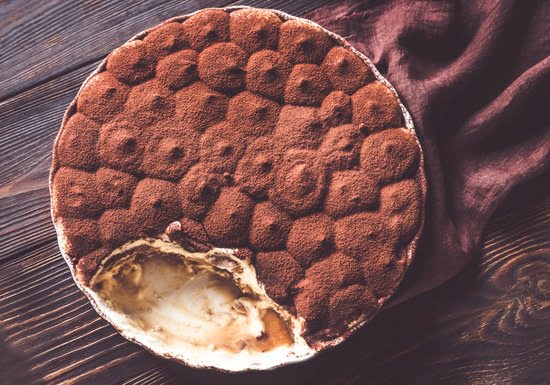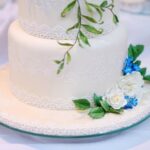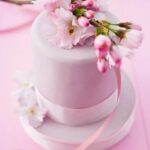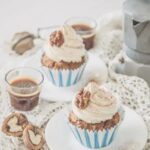Are you looking to decorate a cake without using buttercream? Whether you’re seeking a lighter alternative or simply want to explore different options, there are plenty of creative alternatives to traditional buttercream frosting.
From fondant and whipped cream frosting to ganache and cream cheese frosting, there are numerous ways to achieve beautiful and delicious cake decorations without relying on buttercream. In this article, we’ll explore some of the most popular alternatives for cake decorating, providing step-by-step guides, tips, and techniques for each option.
If you’re tired of the heavy texture and overly sweet taste of buttercream, then you’re in the right place. We’ll show you how to create stunning cakes using fondant, whipped cream, ganache, cream cheese frosting, meringue, fresh fruit, and even edible flowers as decorative elements. Whether you’re a beginner or an experienced baker looking to try something new, these alternative options will open up a world of creative possibilities for your cake decorating endeavors.
So if you’re ready to step outside the buttercream box and explore new avenues for cake decoration, join us as we delve into the exciting world of alternatives to buttercream frosting. From classic techniques to innovative ideas, there’s something here for everyone looking to add a unique touch to their next cake creation. Let’s get started.
Fondant
First, you will need to prepare the fondant by kneading it until it becomes pliable. This can be done by adding some powdered sugar to prevent sticking. Once the fondant is ready, roll it out on a clean surface using a rolling pin. The rolled fondant should be large enough to cover the entire cake.
Next, carefully lift the rolled fondant with your hands or by draping it over the rolling pin, and gently place it on top of the cake. Smooth out any air bubbles and creases using a fondant smoother or your hands. Trim off any excess fondant from the bottom of the cake with a sharp knife.
Now comes the fun part – shaping and coloring the fondant. You can create shapes, figures, flowers, or other decorations using cookie cutters, molds, or by hand sculpting. Fondant can also be colored using gel food coloring to achieve vibrant and custom shades for your cake design.
Applying fondant to a cake may seem intimidating at first, but with some practice and patience, you can master this technique and create stunning cakes without using buttercream. So next time you’re wondering how to decorate a cake without buttercream, consider giving fondant a try for its versatility and beautiful finish.
Whipped Cream Frosting
- Stability: When using whipped cream as frosting, it’s important to stabilize it to ensure that it holds its shape. One way to do this is by adding gelatin to the whipped cream, which will help maintain its structure and prevent it from deflating.
- Chilling the Bowl and Whisk: Before whipping the cream, make sure that the mixing bowl and whisk are thoroughly chilled. This helps the cream whip up faster and reach stiff peaks more easily.
- Flavoring and Coloring: You can add various flavors such as vanilla extract, cocoa powder, or fruit puree to enhance the taste of the whipped cream. Additionally, food coloring can be used to achieve different hues for your cake decorating needs.
- Piping Techniques: Whipped cream can be piped onto cakes using a piping bag and different decorative tips. You can create beautiful borders, swirls, rosettes, or any other design you desire with ease.
Remember that whipped cream is best used on cakes that will be served immediately or stored in the refrigerator until serving time. Whether you’re looking for a lighter alternative to buttercream or simply want to try something new, whipped cream frosting offers a delightful option for decorating your next cake without using buttercream.
Ganache
To make ganache, you only need two simple ingredients: chocolate and heavy cream. The ratio of chocolate to cream will determine the consistency of the ganache, whether you want it to be pourable or spreadable.
By heating the cream until it simmers and then pouring it over the chopped chocolate, you can create a luscious mixture that is perfect for frosting cakes or dipping pastries. Once the ganache is made, allowing it to cool slightly before applying it to your cake will ensure that it achieves the desired texture.
When applying ganache to a cake, start with a crumb coat of ganache to seal in any loose crumbs before adding additional layers or decorations. Using a palette knife or an offset spatula, spread the ganache evenly across the top and sides of the cake, smoothing out any imperfections as you go. The glossy finish of ganache creates an elegant base for further embellishments such as fresh fruit or edible flowers.
In addition to its luxurious appearance, using ganache for cake decorating also offers a sumptuous flavor profile that pairs beautifully with various cake flavors. Whether you’re making a classic chocolate cake or experimenting with unique flavor combinations, ganache can add an extra layer of richness and sophistication. Experimenting with different types of chocolate and flavored extracts can also provide endless opportunities for creativity when using ganache as a decorative element on your cakes.
| Ganache Making Skill Level | Intermediate |
|---|---|
| Main Ingredients | Chocolate, Heavy Cream |
| Application Tool | Palette Knife or Offset Spatula |
Cream Cheese Frosting
To decorate a cake with cream cheese frosting, start by ensuring that the cake layers are completely cooled before applying the frosting. This will prevent the frosting from melting or becoming too runny. Once the cake is ready, prepare the cream cheese frosting by mixing cream cheese, butter, powdered sugar, and vanilla extract until smooth and creamy.
When applying cream cheese frosting to a cake, consider using a crumb coat to seal in any loose crumbs and create a smooth base layer. After applying the crumb coat, refrigerate the cake for about 30 minutes to allow the frosting to set before adding additional layers or decorations. Cream cheese frosting can also be piped onto cakes using pastry bags and decorative tips to create intricate designs and patterns.
In addition to using cream cheese frosting as an alternative to buttercream for decorating cakes, it can also be flavored with various extracts or additions such as lemon zest, cocoa powder, or even crushed nuts for added depth of flavor. The tangy and rich profile of cream cheese frosting makes it an ideal choice for complementing both sweet and savory cake flavors, providing decorators with endless possibilities for creating visually stunning and delicious cakes without using traditional buttercream.
Meringue
Making Meringue
To start, you will need to prepare the meringue mixture. This typically involves beating egg whites and sugar until stiff peaks form. You can add flavorings or colorings as desired, such as vanilla extract or gel food coloring. The key is to achieve a smooth and glossy texture that holds its shape when piped onto the cake.
Piping Techniques
Once your meringue mixture is ready, it’s time to pipe it onto the cake. Using a piping bag fitted with a decorative tip, carefully squeeze the meringue onto the surface of the cake in whatever pattern or design you desire. You can create intricate swirls, rosettes, or even write messages with meringue. The lightness of meringue allows for flexibility in design and provides an ethereal touch to the finished product.
Final Touches
After piping the meringue onto the cake, you can further enhance its appearance by using a culinary torch to lightly toast the meringue. This not only adds a subtle caramelized flavor but also creates an attractive golden finish. Alternatively, you can leave the meringue as is for a pristine white appearance that imparts an elegant and modern look to your creation.
Using meringue as a decorative element for cakes opens up endless possibilities for creatively adorning your confections without relying on traditional buttercream. Experiment with different flavors and colors of meringue to create visually stunning designs that elevate your cakes to new heights of artistry and taste.
Fresh Fruit
When it comes to cake decorating, there are numerous alternatives to traditional buttercream. One popular and visually appealing option is using fresh fruit as a decorative element. Not only does it add natural beauty to the cake, but it also provides a delicious and refreshing contrast to the sweetness of the cake itself. In this section, we will explore how to effectively use fresh fruit as a cake decoration, including tips on placement and arrangement.
One of the key aspects of using fresh fruit for cake decoration is choosing the right fruits that complement the flavor of the cake. For example, berries such as strawberries, blueberries, and raspberries work well with various cake flavors due to their vibrant colors and juicy texture. Tropical fruits like mangoes, kiwis, and pineapple can add an exotic touch to the cake. Additionally, citrus fruits like oranges and lemons can bring a zesty and refreshing flavor profile to the dessert.
Once you have selected the appropriate fruits for your cake decoration, it’s important to consider the placement and arrangement. Depending on your design aesthetic, you can opt for neatly sliced pieces arranged in a specific pattern or go for a more organic look with whole or halved fruits scattered artfully across the top of the cake.
Another creative way to use fresh fruit is by creating patterns or designs with different colored fruits as a centerpiece for your decorated cake.
| Fruit | Complementing Cake Flavor |
|---|---|
| Berries (Strawberries, Blueberries, Raspberries) | Various flavors due to vibrant colors and juicy texture |
| Tropical Fruits (Mangoes, Kiwis, Pineapple) | Add an exotic touch to the cake |
| Citrus Fruits (Oranges, Lemons) | Zesty and refreshing flavor profile |
Edible Flowers
Choosing Edible Flowers
When selecting edible flowers for cake decorating, it is crucial to ensure that they are safe for consumption and have not been treated with pesticides or chemicals. Popular choices for edible flowers include varieties such as roses, lavender, pansies, violets, and nasturtiums. It is also important to verify the source of the flowers and to thoroughly wash them before use.
Incorporating Edible Flowers Into Cake Designs
There are numerous creative ways to incorporate edible flowers into cake designs. One popular method is to delicately place whole blooms or petals on top of the cake or around the edges for a simple yet elegant look. Another option is to crystallize the flowers by lightly brushing them with egg whites and dusting them with sugar, creating a beautiful frosted effect.
Safety Considerations
Before using edible flowers on a cake, it’s essential to consider any potential allergies or sensitivities that guests may have. While many people can consume edible flowers without issue, it’s always best to inform guests about the presence of edible flowers in the cake decoration. If you are unsure about any potential allergic reactions, it’s wise to err on the side of caution and avoid using certain types of flowers.
By incorporating edible flowers into cake decorating, bakers can create visually stunning and unique designs that add a touch of natural beauty to their creations. Whether used as a subtle accent or as a focal point, edible flowers offer an array of options for adding color and vibrancy to cakes without relying on traditional buttercream frosting.
Conclusion
In conclusion, there are numerous creative and delicious alternatives to buttercream for cake decorating. From fondant to whipped cream frosting, ganache, cream cheese frosting, meringue, fresh fruit, and edible flowers, there are endless possibilities for creating beautiful and unique cakes without using traditional buttercream. Each option offers its own set of benefits and techniques, allowing bakers to experiment with different flavors, textures, and designs.
For those looking to explore how to decorate a cake without buttercream, the key is to have an open mind and a willingness to try new methods. Whether it’s shaping and coloring fondant, piping meringue into delicate designs, or strategically placing fresh fruit and edible flowers on a cake, there is something for every baker to enjoy. It’s about embracing creativity and thinking outside the box when it comes to cake decorating.
So next time you’re preparing for a special occasion or simply want to indulge your sweet tooth with a beautifully decorated cake, consider stepping outside of the buttercream box. With these alternative options at your disposal, you can take your cake creations to new heights and impress your friends and family with stunning designs that are as delicious as they are visually appealing.
Embrace the versatility of these alternatives and let your creativity run wild as you discover the endless possibilities for decorating cakes without buttercream.
Frequently Asked Questions
What Can I Use Instead of Buttercream on a Cake?
Instead of using buttercream on a cake, you can consider using cream cheese frosting, whipped ganache, or chocolate glaze. These alternatives can provide different flavors and textures to your cake while still being deliciously decadent.
Can You Decorate a Cake Without Buttercream?
Yes, you can definitely decorate a cake without using buttercream. There are various options such as fondant, marzipan, or even fresh fruit and edible flowers. Each of these choices offers unique decorating opportunities and can result in a beautifully decorated cake.
What Can I Put on Top of Cake Besides Frosting?
Besides frosting, there are many delicious options to put on top of a cake. You could opt for a drizzle of caramel or chocolate sauce, a dusting of powdered sugar or cocoa powder, or even a dollop of whipped cream with fresh berries. These alternatives provide variety and visual appeal to your cake without the need for traditional frosting.

Welcome to our cake decorating blog! My name is Destiny Flores, and I am the proud owner of a cake decorating business named Cake Karma. Our mission is to provide delicious, beautiful cakes for all occasions. We specialize in creating custom cakes that are tailored specifically to each customer’s individual needs and tastes.





